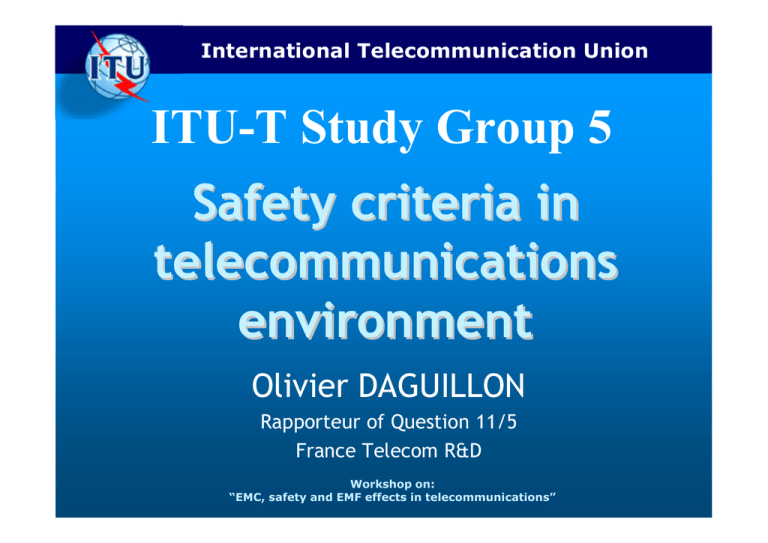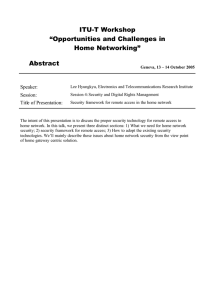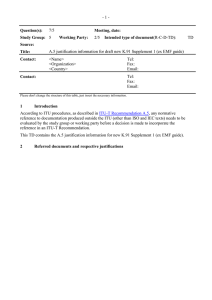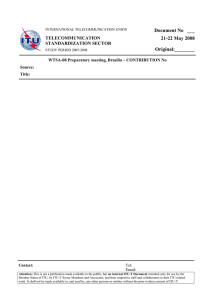ITU-T Study Group 5 Safety criteria in telecommunications environment
advertisement

International Telecommunication Union ITU-T Study Group 5 Safety criteria in telecommunications environment Olivier DAGUILLON Rapporteur of Question 11/5 France Telecom R&D Workshop on: “EMC, safety and EMF effects in telecommunications” Safety criteria in telecommunications environment ITU-T Study Group 5 o o o o o 07.11.01 Mandate of Question 11 Study Group 5 Approach Recommendation K.50 Recommendation K.51 Current and future efforts Workshop on: “EMC, safety and EMF effects in telecommunications” 2 Mandate of Question 11 ITU-T Study Group 5 o Title : “Maintenance and enhancement of existing Recommendations related to human safety in the telecommunications environment” o SG 5 produces : • safety requirements for telecommunication equipment ; • safe working practices for network operator personnel. 07.11.01 Workshop on: “EMC, safety and EMF effects in telecommunications” 3 SG5 Approach ITU-T Study Group 5 o Study Period 1996-2000 (Question 5) • Focus on the development of K.50 and K51 o Study Period 2001-2004 • Update existing recommendations • Suggest new areas of study 07.11.01 Workshop on: “EMC, safety and EMF effects in telecommunications” 4 SG5 Approach ITU-T Study Group 5 o The domain of IEC TC 74 deals with safety requirements for information technology equipments o Remote Feeding Telecommunication circuits used by Telcos in their networks were not standardized by IEC 60950 07.11.01 Workshop on: “EMC, safety and EMF effects in telecommunications” 5 SG5 Approach ITU-T Study Group 5 o With its knowledge of the networks, SG 5 worked on safety requirements for RFT circuits extended to the cables of networks o SG5 produced 2 Recommendations which will be included in IEC Standard • To provide guidance on voltages and currents that may safely be used to power telecommunication systems that are part of the network • To give guidance on safety criteria for telecommunication network infrastructure equipment 07.11.01 Workshop on: “EMC, safety and EMF effects in telecommunications” 6 SG5 Approach ITU-T Study Group 5 o Definitions from IEC 60950 : • SELV : Safety Extra Low Voltage • TNV1, 2 or 3 : Telecommunication Network Voltage o Definitions from SG 5 : • RFT : Remote Feeding Telecommunication “ A circuit, other than SELV or TNV circuit, intended for the supply of power to equipment via a pairedconductor network, and which is so designed and protected that under normal operating and single fault conditions the voltages or currents do not exceed defined values.” 07.11.01 Workshop on: “EMC, safety and EMF effects in telecommunications” 7 SG5 Approach ITU-T Study Group 5 o Recommendation K.50 : “ Safe limits of operating voltages and currents for telecommunication systems powered over the network ” o Recommendation K.51: “ Safety criteria for telecommunication Equipment ” 07.11.01 Workshop on: “EMC, safety and EMF effects in telecommunications” 8 K.50 - Scope ITU-T Study Group 5 o To give guidance on voltages and currents that may safely be used to power telecommunication systems that are part of the network. o The support may be the paired-conductor cables of the network or specific power feeding cables to provide power to equipment at remote locations. o This equipment and the current carrying conductors can be accessed in the energized state by service personnel without using insulated gloves or tools. 07.11.01 Workshop on: “EMC, safety and EMF effects in telecommunications” 9 K.50 – Field of application ITU-T Exchange Trunk network Exchange Study Group 5 • • • • TNV-1 TNV-3 RFT-C RFT-V Field of application of K.sovnetwork in the trunk network In the trunk Exchange Customer premise Telecommunication access network Telecommunication equipment in the access network • • • • Public network interface Customer premise equipment TNV-1 TNV-3 RFT-C RFT-V Field of application In the of access K.sov innetwork the access network 07.11.01 T0508800-99 T0508810-99 Workshop on: “EMC, safety and EMF effects in telecommunications” 10 K.50 - Definitions ITU-T Study Group 5 o RFT-C : Remote Feeding Telecommunication Circuit - Current limited o RFT-V : Remote Feeding Telecommunication Circuit - Voltage limited NOTE - The definition of circuits in IEC 60950 is limited to circuits internal to equipment. For this recommendation the definition of circuits is extended to include conductors that carry the same voltages/currents. 07.11.01 Workshop on: “EMC, safety and EMF effects in telecommunications” 11 K.50 – RFT-V Circuits ITU-T o Study Group 5 Aim : to limit the voltage so that the insulation or the resistance of the body limits the current to tolerable levels. o Limits under normal conditions : • Open circuit voltage from each conductor to earth shall not exceed: • 140 V dc, or • 200 V dc if the short circuit current < 10 mA dc ; • the maximum power shall be limited to 100 VA after 1 s • the steady state current that can flow into the telecommunication network shall comply with Clause 6.3 of IEC 60950 (telecommunication wiring limit) 07.11.01 Workshop on: “EMC, safety and EMF effects in telecommunications” 12 K.50 – RFT-V Circuits ITU-T Study Group 5 o Limits under single fault conditions : • during the first 200 ms, the output voltage per conductor to earth or between conductors, does not exceed the limits of Figure A.1/K.50; and 1 500 V peak Voltage (V) 1 500 for 400 V < U < 1 500 V: U = 1 000 1 500 T T0 Figure A.1/K.50 400 V peak or dc 500 0 U in volts T in milliseconds T 0 = 1 ms Limits of 2.3.1 b) normal operating conditions 1 5 10 14 15 200 205 Time T (ms) T0508820-99 • after the first 200 ms the limits of A.1 are met. 07.11.01 Workshop on: “EMC, safety and EMF effects in telecommunications” 13 K.50 – RFT-C Circuits ITU-T Study Group 5 o Aim : to limits the current of the remote power feeding circuit so that higher voltages can be allowed. o Limits under normal conditions : • the steady state current in the telecommunication network shall not exceed 60 mA dc under any load condition; • the steady state current from one conductor to earth shall not exceed 2 mA dc; • The voltage is limited to the specified voltage rating of the wiring of the telecommunication network or to a maximum value of 1 500 V, whichever is lower or The voltage shall be limited to 800 V between conductors of the telecommunication network if the voltage rating is not specified 07.11.01 Workshop on: “EMC, safety and EMF effects in telecommunications” 14 K.50 – RFT-C Circuits ITU-T Study Group 5 o Limits under single fault conditions : • the current in an RFT-C circuit shall not exceed the relevant limit given in Figure B.1/K.50. I dc [mA] 1 000 100 10 0.01 0.1 time [s] 1 10 T0508830-99 line to line line to earth Figure B.1/K.50 : Maximum current after a single fault 07.11.01 Workshop on: “EMC, safety and EMF effects in telecommunications” 15 K.50 – RFT-C Circuits ITU-T o Study Group 5 Limits with one conductor earthed • the current from the other conductor to earth shall not exceed the relevant line-toearth limit given in Figure B.1/K.50; and • the open circuit voltage to earth of the other conductor shall not exceed the voltage rating of the network wiring. The measurement is made after at least 2 s. NOTE - Unless the current limits in Clauses B.1, the RFT-C circuit shall have a monitoring and control device (e.g. balance control), which operates in such a way as to maintain the required current limits. 07.11.01 Workshop on: “EMC, safety and EMF effects in telecommunications” 16 K.50 – RFT Circuits ITU-T Study Group 5 o Coordination with surge protective devices • RFT-V supply equipment shall control the supply current so that an agreed SPD will automatically return to its high-impedance state after a transient o Installation instructions for interconnection • the capacitances of the equipment do not exceed the values specified in Figure B.2/K.50 • the voltage rating of the network must be adequate for the normal RFT circuit voltage, together with any superposed transient 07.11.01 Workshop on: “EMC, safety and EMF effects in telecommunications” 17 K.50 – RFT Circuits ITU-T o Installation instructions for interconnection 10 000 V [V] Study Group 5 1 000 100 0.01 0.1 1 10 100 1 000 C [µF] 10 000 T0508840-99 line to line line to earth 07.11.01 Limits for capacitance values of RFT circuits or the total system Workshop on: “EMC, safety and EMF effects in telecommunications” 18 K.50 – RFT Circuits ITU-T Study Group 5 o Work practices • Normal general work practices • RFT circuits accessed in the energized state by service personnel without de-energizing the circuits or using insulated gloves or tools. • The service personnel should be informed that RFT can be present in the network. • Special work practices • To prevent any contact with simultaneously several RFT-C circuits, they shall be suitably labelled or appropriately marked to alert service personnel. Guidance on work practices, if the limits of RFT circuits are exceeded, can be found in Volumes VI and VII of the Directives. 07.11.01 Workshop on: “EMC, safety and EMF effects in telecommunications” 19 K.51 - Scope ITU-T Study Group 5 07.11.01 o This recommendation specifies requirements intended to reduce risks of fire, electric shock or injury for people into contact with the equipment. o It refers to IEC 60950 and provides additional requirements when these are not covered by IEC 60950. o Work in cooperation with IEC TC74. Workshop on: “EMC, safety and EMF effects in telecommunications” 20 K.51 – Safety criteria ITU-T o Study Group 5 Protection from electric shock and energy hazards • In user access areas : • The equipment shall have an adequate protection against contact with bare parts of RFT circuits. • In service access areas : • Bare parts at hazardous voltage, including RFT circuits, shall be located or guarded • In restricted access locations : • The contact is permitted with the bare parts of RFT circuits by the test finger (Figure 2A of 60950). However such parts shall be so located or guarded that unintentional contact is unlikely. 07.11.01 Workshop on: “EMC, safety and EMF effects in telecommunications” 21 K.51 – Safety criteria ITU-T Study Group 5 o Interconnection of equipment • General requirements • An RFT circuit can be an interconnection circuit. • Provision of continued conformance to the requirements of K.50 for RFT circuits, after making the connections. • Interconnection between RFT circuits • The interconnection of one RFT-V circuit to another RFT-V circuit shall not result in exceeding the limits specified in K.50. • The interconnection of one RFT-C circuit to another RFT-C circuit shall not result in exceeding the limits specified in Annex B of K.50 07.11.01 Workshop on: “EMC, safety and EMF effects in telecommunications” 22 K.51 – Safety criteria ITU-T Study Group 5 o Protection from hazardous voltages • Circuitry intended to be directly connected to a telecommunication network shall comply with the requirements of an SELV, TNV or an RFT circuit. o Separation from other circuits and parts • other RFT circuits by functional isolation; • ELV circuits by supplementary insulation; • earthed accessible parts, SELV circuits and TNV circuits by basic insulation; • unearthed accessible parts, SELV circuits, TNV circuits and circuits at hazardous voltages by one or both of the following: • double or reinforced insulation; • basic insulation, together with protective screening connected to the main protective earthing terminal. 07.11.01 Workshop on: “EMC, safety and EMF effects in telecommunications” 23 K.51 – Information ITU-T Study Group 5 o Installation instructions o Cross reference with paragraphs of IEC 60950 where similar requirements are given. 07.11.01 Workshop on: “EMC, safety and EMF effects in telecommunications” 24 ITU-T Study Group 5 Study Period 2001-2004 Question 11 : Maintenance o Maintenance of K.50 and K.51 o Collaboration with TC 74 • RFT requirements will be in the Part 21 of the 4th Edition of IEC 60950 • Amendment of the Power Contact requirements proposed by IEC 07.11.01 Workshop on: “EMC, safety and EMF effects in telecommunications” 25 ITU-T Study Group 5 Study Period 2001-2004 Question 11 : New areas o Evaluation of safety requirements related to safe working practices for outside equipment installed in a particular environment, e.g. in high humidity environment • Kswp “Safe working practices for outside equipment installed in particular environment” o Evaluation of safety requirements related to CATV networks o Evaluation of safety requirements for equipment interfaces in case of installation in different buildings 07.11.01 Workshop on: “EMC, safety and EMF effects in telecommunications” 26 ITU-T Study Group 5 Study Period 2001-2004 Question 11 : Liaisons o ITU-T • SG 5 Question 6 • SG 13 o Other Standardization Institutes • IEC TC 74 • ETSI TC Safety (European Telecommunications Standard Institute) 07.11.01 Workshop on: “EMC, safety and EMF effects in telecommunications” 27




